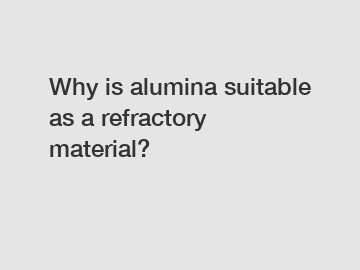Why is alumina suitable as a refractory material?
You will get efficient and thoughtful service from YT.
Why is alumina suitable as a refractory material?
Alumina, also known as aluminum oxide (Al2O3), is widely recognized as one of the most suitable materials for refractory applications. Its unique properties make it an ideal choice for high-temperature environments where other materials might fail. So, what exactly makes alumina so suitable as a refractory material? Let's delve into its characteristics and discuss the reasons behind its widespread use in refractory applications.

1. High melting point:
Alumina possesses an exceptionally high melting point of approximately 2050°C (3720°F). This crucial property allows it to withstand extreme temperatures without undergoing significant deformation or degradation. Such capability is essential in refractory applications as it ensures the material remains stable and can effectively contain and withstand high temperatures.
2. Thermal shock resistance:
Refractory materials are often subject to rapid changes in temperature due to various industrial processes. Alumina exhibits exceptional thermal shock resistance, enabling it to endure sudden temperature fluctuations without cracking or fracturing. This property makes alumina ideal for applications that involve frequent heating and cooling cycles, such as in furnaces and kilns.
3. Chemical inertness:
Many refractory applications involve corrosive or reactive environments, which can cause materials to degrade or react with the surrounding atmosphere. Alumina, however, displays excellent chemical stability and inertness. It is highly resistant to a wide range of acids, bases, and other corrosive substances, making it a reliable choice in industries like metallurgy, petrochemicals, and ceramics.
4. Mechanical strength and hardness:
Alumina is renowned for its exceptional mechanical properties. It exhibits remarkable hardness and strength, making it resistant to wear and abrasion. Its strength allows it to maintain its structural integrity even under extreme mechanical stress. These properties are especially crucial in industries such as steelmaking, where refractory materials are subjected to heavy mechanical loads.
5. Electrical insulation:
Certain refractory applications require materials with good electrical insulation properties. Alumina has excellent electrical insulation characteristics, meaning it does not conduct electricity. This property allows it to be used as insulation in various high-temperature electrical systems, including heating elements and electrical insulators in furnaces.
6. Low thermal conductivity:
Efficient heat management is essential in refractory applications to control and direct heat flow. Alumina exhibits low thermal conductivity, meaning it has the ability to retain and contain heat within a confined space. This property allows for optimized temperature control and improved energy efficiency in applications such as kilns, reactors, and combustion chambers.
Conclusion:
Alumina's unique combination of high melting point, thermal shock resistance, chemical inertness, mechanical strength and hardness, electrical insulation, and low thermal conductivity make it an exceptionally suitable material for refractory applications. Its ability to withstand extreme temperatures, resist thermal shock and chemical degradation, and maintain structural integrity under mechanical stress ensures its wide usage in industries ranging from steelmaking to ceramics. With its remarkable properties, alumina continues to play a vital role in the development and improvement of refractory materials, enabling safer and more efficient high-temperature processes across various industries.
For more information, please visit fireclay brick manufacturer.



